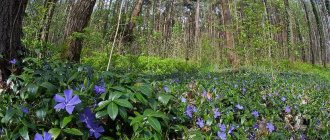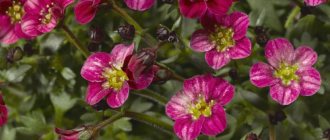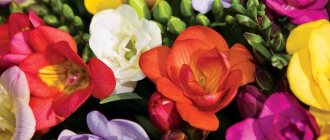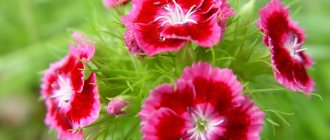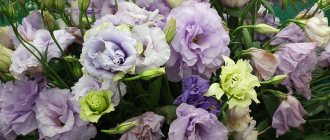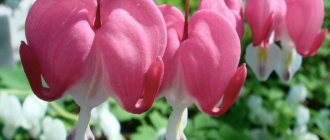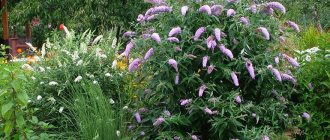Review author: Terrari School of Design
We can safely say that Phlox remains a favorite in the country landscape. And all because the perennial is distinguished by its variety of colors, aroma and ability to decorate any flower beds.
70 species of phlox are now known. But only half of them are used. The most famous, of course, is Phlox paniculata, its varieties and hybrids have long gone ahead of their ancestors in terms of the wide variety of flower colors. Many of today's hybrids have been bred to be resistant to powdery mildew.
More than 1000 new flowers were developed in our country alone. The uncultivated form, in its natural habitat, grows everywhere.
Medium sized plants will look great alone or in a group
The height of a bush is its species: there are very small ones below 35 cm, and there are very tall varieties, above 160 cm. Which allows you to divide phloxes into groups, according to this criterion:
- tall (up to 180 cm), flowering - summer and early autumn: Phlox paniculata;
- bush, height up to 70 cm, beginning of flowering - from the end of April: thick-leaved phlox, f. hairy, etc.;
- a transitional species, there are bush varieties and there are creeping varieties (up to 35 cm), flowering begins from April to July. Phlox spread apart (spread out) and phlox stoloniferous;
- creeping plants, up to 15 cm in height, bloom from spring to mid-summer. F. awl-shaped, f. Douglas, etc.;
- Drummond phlox, one of the favorite garden annuals, should be placed in a separate group. The height does not exceed 30 cm. The flower is painted in all sorts of colors and shades: from white to purple. Flowering is friendly and long. Propagates well by self-sowing.
Phlox awl-shaped is a perennial, no more than 17 cm in height. Flowering is early, late May. Forms a continuous carpet. The flowers are small, of different colors - from white to blue.
The plant looks very decorative due to its evergreen elongated leaves. Great for alpine slides. Popular varieties f. awl-shaped: Maishnee, Appel Blossum, Thumbelina, Candy stripes.
The individuality of each variety is also evident in the inflorescence. Plants differ in the shape and size of the inflorescence, as well as in the color of the flower. Breeders in many countries continue to work on flower color all the time. The color of various hybrids is impressive: white, coral, pink, red, crimson, purple, violet, lilac. There are Dutch hybrids that change color depending on the time of day.
Selection by color scheme
In terms of color palette, phlox provides a wide choice in color variations from snow-white to rich crimson and dark purple. The palette completely lacks only yellow and its shades, so this plant is an ideal choice for those who adore all kinds of variations of white-pink-lilac colors.
The delicate color of phlox with a clear romantic character goes well only with white-flowering plants, which emphasize its elegance and romance, as well as the dark purple shades of the inflorescences of neighbors, which give depth to the compositions and, as it were, “highlight” a group of phlox. Light yellow, cream, soft beige tones, which give flower beds a discreet aristocracy and harmonious lightness, will not spoil your flower garden.
Care
Spring
- Perennial plantings of phlox require care. The old bush is divided and cuttings can begin. It's time to tie up tall varieties.
- Spring is the time when you need to apply a complex fertilizer with a predominance of nitrogen. In the absence of rain, watering is required.
Summer
- If phloxes are planted on poor soils, then feed them with nitrogen again in June.
- In July, water with an infusion of wood ash; after the phloxes have flowered, apply phosphorus-based fertilizer.
- In summer, control over self-seeding is important. In order not to lose the characteristics of the variety, and to prolong flowering, you need to remove faded inflorescences. And don't forget to water.
- Landscape design: giant varietal plants can fit perfectly into the background of a flower bed.
Autumn
- In September it is time to divide the bush. Phloxes are cut to the ground.
- For the winter, the bush is mulched and, if necessary, covered with additional material.
Advice. In order for the flowerbed to be decorative and blooming all season long, you should plant together: Phloxes, daylilies and peonies.
Cereals, monardas, and saplings are perfect for phloxes in pink, lilac, and purple tones.
Landing
For perennial phlox, planting and care is as follows:
- correct choice of cuttings;
- landing time;
- landing features;
- bends;
- division;
- seeds.
The easiest way is cuttings. It is better to buy seedlings from professional flower growers. The best landing time is April-May.
In any case, build on the climatic characteristics of the region. In addition, perennials take root in the open ground, and already next September you can admire the flowering.
On the Internet you can see photos of different varieties of phlox with names. If you decide to use autumn planting, then this should be done long before frost. Otherwise the plant will freeze.
Location and lighting
The plant can grow both in the sun and in the shade, but in the sun the phlox flowers will be better and the inflorescence itself will be more magnificent, while in the shade the flower will be duller and the inflorescences will be loose. But the shade will allow the phlox to bloom longer. In southern regions, shading is required.
Advice. In order for the plants to bloom for a long time, you should plant them in the “Sherbet Cocktail” or “Sherbet Blend” area - these varieties bloom for the longest time.
Description
Perennial phlox is a decorative flower with bright petals and a delightful aroma. The plant is native to North America. In translation, its name is translated as “flame” - due to the fact that previously phloxes were only scarlet.
But now, thanks to breeding work, we can grow varieties of different shades: you can also find purple, pink, crimson, blue, and white. Today, about 40 cultivated varieties of perennial phlox are known, which have more than a hundred different varieties.
Externally, the plant is a bush with a height of 10 centimeters to one and a half meters. It has straight, even stems and regular oval-shaped leaves.
At the end of the stem there is an inflorescence that can have up to 90 small flowers. The flower itself is tubular in shape, always with five petals.
Temperature
In winter, down to -15°C (without snow cover), 2 weeks are enough for the growth buds to freeze out, and at -20...-25°C the rhizome will die irrevocably. To prevent this from happening, you should cover the wintering plant with bast leaves, not with woven material.
If there is up to half a meter of snow, the plant, without harming itself, can overwinter without additional shelter even at -35°C.
A spectacular combination with catnip
Although phlox can be combined with many types of plants, they look most advantageous when catnip grows next to them. Small spikelets of catnip, light lilac in color, favorably set off almost all types of phlox. This combination gives the flowerbed fullness and harmony. In addition, the essential oil content in catnip helps repel certain pests.
Cat mint
Annual daisies help to further enhance the effectiveness of the above-described composition. Nivyanik has a white color and low growth, so it will not block the beauty of phlox. But against the backdrop of daisies, the bright colors of the perennial will become more juicy and saturated.
Humidity
Phlox love moisture, but cannot tolerate standing water at their roots. Lowlands, where water collects and stands for a long time, and where ice forms in cold weather, are not the place for them.
Advice. To avoid rotting of phlox roots when groundwater is shallow, it is necessary to plant the plant on a raised bed (up to 15 cm).
Getting ready for winter
In the southern regions there is no need to cover plants. But already from the middle zone for the winter they need to be “bundled” from the cold. Before this, they are cut off at the root.
We recommend reading:
- Flowers in August: photos and description
- Garden flowers that bloom in July: photos and names
- Lilac - varieties, types, selection rules, planting nuances, cultivation secrets and care (105 photos and videos)
The root part is mulched with straw and other organic matter. Burlap and agrofibre cope well with the task. In the northern regions, roots are dug up and stored in basements or boxes.
Reproduction
Phlox reproduce in all sorts of ways.
Seeds
The flower produces good germination from self-sowing. But varietal affiliation disappears. This method is good for annual phlox drummondi.
Stem cuttings
The method is simple for beginner phlox lovers. A strong shoot is suitable for cuttings. Divide into cuttings with two nodes. The cuttings are planted in the ground. Water frequently - up to 3 times a day. After rooting, young shoots will emerge from the leaf axils.
Root cuttings
This method is best used in the spring. After digging up the flower, select a high-quality root and cut it into pieces. Place in a container with soil and cover from light. Keep at 15°C for 14 days. Then raise the temperature to 25°C and plant in the soil when sprouts appear.
Axillary buds
Along with a small piece of the stem, a leaf with a bud is cut off. This cutting is planted in the ground and covered with glass, the temperature is no more than 20°C. The substrate is wet. Rooting will occur in approximately 30 days if watering standards are observed.
Dividing the bush
The procedure is carried out in spring and autumn. The division of the bush begins at 6 years of age. The bush is dug up and taken apart. Planting is done immediately, watering is required. Phlox varieties are preserved in this way.
How to properly plant a flowerbed with your own hands
To create a flower garden at your dacha, you first need to choose the optimal place for it, carefully dig up the area, and remove the remains of the roots and stems of the plants. Before planting flowers in a prepared flowerbed, you need to display it on a piece of paper. A detailed diagram helps you choose plants that fit perfectly together.
Diseases
If brown, loose spots appear on the stem, this is Phoma. With this disease, the leaves curl and dry out. The use of the drugs “Hom” and “Abiga-Peak” will help. The amount of mineral fertilizers should be applied. Those plants that are not deficient in phosphorus and potassium are resistant. But with an excess of nitrogen fertilizers, the immunity of phloxes weakens.
If not properly cared for, phlox will look depressed and weak; plants suffering from lack of water will develop powdery mildew. The disease begins from the lower part of the plant with the appearance of plaque on the leaves. Then the plaque darkens, and these spots cover the entire plant. Treatment - “Skor”, “Topaz”, “Ridomil Gold”
Advice: Remove and burn a plant infected with powdery mildew. Disinfect working tools.
Rules for composing flower arrangements
Visiting floral exhibitions, people are amazed by the imagination and talent of the craftsmen who create real masterpieces even from ordinary-looking plants. Composing an exquisite flower arrangement requires not only ability and inspiration, but also knowledge of the basic rules of floristry.
Before you start creating a flower bed, you need to draw or draw up a design in your mind, and based on it, create a composition. A flower that has a contrasting shade to the main background is usually chosen as the main point.
Imagining what the flowerbed should look like, divide it into 8 parts of the same size.
To make the composition look bright and interesting, plants of different heights and colors are used.
The bouquet seems weightless if light colors are combined; dark ones make it heavy and lush. To give harmony to the flowerbed, you need to choose the right colors. The palette should be restrained, not flashy. Shades of the same paint are always successfully combined; contrasting tones in a certain sequence look good, starting with red and orange, and ending with blue and purple.
Photos of phlox
Peculiarities
Flowers are an important attribute of almost every site. They perfectly complement the texture and also create the original shape of the landscape, giving it a special tone. It is flower arrangements that serve as a connecting element in relation to other plants located in the garden, as well as an essential component of the landscape design of any country house.
When creating flower beds, not only flowers can be used, but also shrubs or trees.
In the process of creating flower arrangements, it is recommended to use not only the general patterns of color perception, but also the basic principles of choosing plants with the most correct combination of them.

